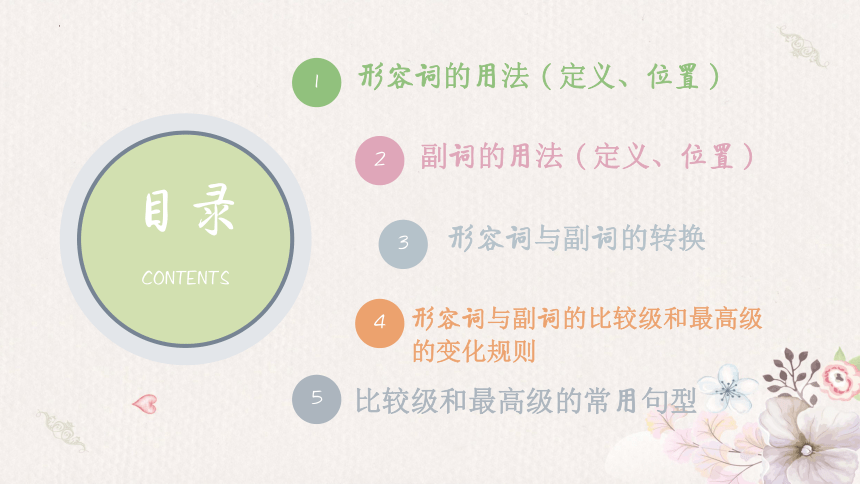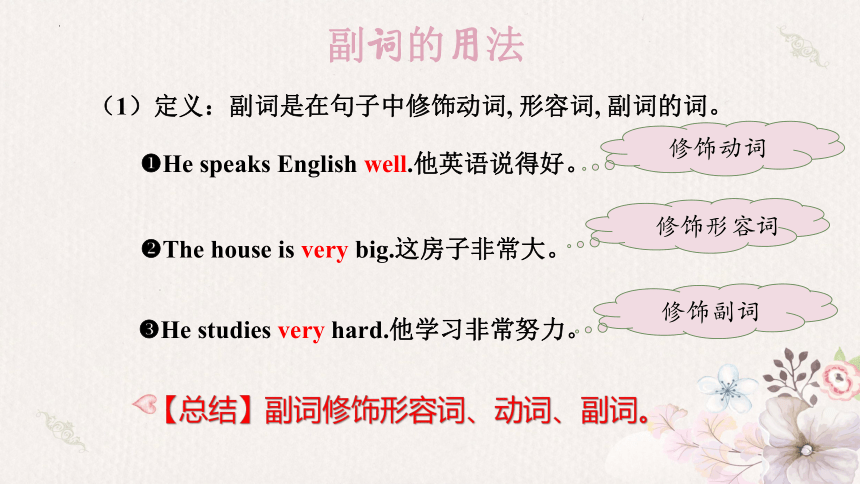2024年人教版中考英语复习形容词、副词比较级&最高级 课件(共27张PPT)
文档属性
| 名称 | 2024年人教版中考英语复习形容词、副词比较级&最高级 课件(共27张PPT) |  | |
| 格式 | pptx | ||
| 文件大小 | 9.5MB | ||
| 资源类型 | 教案 | ||
| 版本资源 | 通用版 | ||
| 科目 | 英语 | ||
| 更新时间 | 2023-09-11 13:45:38 | ||
图片预览









文档简介
(共27张PPT)
2018.01.01
形容词与副词
比较级最高级
Made by Tessa
目录
CONTENTS
3
2
1
5
4
形容词的用法(定义、位置)
副词的用法(定义、位置)
形容词与副词的转换
形容词与副词的比较级和最高级
的变化规则
比较级和最高级的常用句型
1
PART ONE
形容词的用法
形容词的用法
(1)定义:
用来修饰名词或者代词,表示人或事物“性质、特征和状态”的词。例如:
He is a good student. (表性质)
It’s a big apple. (表特征)
He is happy. (表状态)
形容词的用法
I have a red pig. (名词前)
The pig is big. (be动词后)
注意:一般放在名词前,但遇到不定代词something/anything/nothing/everything
时,形容词要放后面
(2)句中的位置:名词前、be动词后
It’s a yellow pig. She has a red coat.
There is something wrong with the pig.
Would you like something hot to drink
【总结】
① be动词后用形容词;
② 形容词修饰名词,放在名词前面。
修饰不定代词,放在后面。
2
PART TWO
副词的用法
副词的用法
He studies very hard.他学习非常努力。
(1)定义:副词是在句子中修饰动词, 形容词, 副词的词。
He speaks English well.他英语说得好。
The house is very big.这房子非常大。
修饰动词
修饰形容词
修饰副词
【总结】副词修饰形容词、动词、副词。
副词的用法
He runs fast. Very good!
Come here, please! What’s the time now
She swims in the river sometimes.
(2)分类:
方式副词: well fast slowly carefully
程度副词: very much
地点副词: here there home abroad upstairs downstairs
时间副词: today soon yesterday now tonight
频率副词: always often usually sometimes seldom never
3
PART FOUR
形容词与副词的转换
形容词与副词的转换
具体规则如下:
1.一般情况下直接加“ly”,
quick-quickly polite-politely sad-sadly
2. 少数以e结尾的形容词,要去掉e再加-ly。
true-truly
绝大多数辅音字母加e结尾的形容词直接加-ly。
wide-widely wise-wisely nice-nicely
形容词与副词的转换
具体规则如下:
3. 以“y”结尾的,且读音为 / i /, 先将“y”改成“i”,再加“ly”,
happy-happily; heavy-heavily; angry-angrily; busy-busily
但是如果读音为 / ai /, 直接加ly,
dry-dryly; shy-shyly
4.以辅音字母加le结尾时,去e加y,
simple-simply terrible-terribly
形容词与副词的转换
形容词变副词通常是加ly,其变化规律口诀:
一般直接加,“元e”去e
“辅y”改i加,“le”结尾e改y。
quick-quickly true-truly
happy-happily
possible-possibly
4
PART THREE
比较级与最高级
Bumblebee 大黄蜂
高的 tall
taller
更高的
Optimus 擎天柱
bike 自行车
快的 fast
faster
更快的
car 车
big
bigger
biggest
small
smaller
smallest
形容词、副词的级
bigger 更大的 younger 更年轻的 smaller 更小的
原级:形容词、副词的原形
比较级
big 大的 young 年轻的 small 小的
:两个人或物之间的比较
biggest 最大的 youngest 最年轻的 smallest 最小的
最高级
:三个或三个以上的人或物之间的比较
比较级、最高级变化规则
比较级、最高级的变化规则分为规则变化和不规则变化
规则变化
原级 比较级 最高级
一般在词尾加 er/est
small fast
smaller faster
以 e 结尾的加 r/st
large cute
larger cuter
辅元辅+重读闭音节的
双写末尾字母再加 er/est
big
thin
bigger
thinner
辅音+ y 结尾的,y 改为 ier/iest
heavy easy
heavier easier
部分双音节词和多音节词
原形前加 more/most
beautiful
interesting
more beautiful
more interesting
smallest fastest
largest cutest
biggest
thinnest
heaviest easiest
most beautiful
most interesting
比较级变化规则
不规则变化
原级 比较级 最高级
good / well 好的 better 更好的 best 最好的
bad / ill 坏的;病的 worse 更坏的 worst 最坏的
many / much 许多的 more 更多的 most 最多的
little 小的;少的 less 更小的;更少的 least最小的;最少的
far 远的 farther / further 更远的 farthest / furthest最远的
old 老的 elder / older 更老的 eldest / oldest 最老的
5
PART FOUR
比较级和最高级的常用句型
The dog is bigger than the mouse.
The horse is the biggest of all.
big
bigger
biggest
The boy is younger than the man.
The baby is the youngest of the three.
young younger
youngest
Jim
Li Lei
Tom
Li Lei is taller than Tom.
Jim is the tallest of all.
The dog is bigger than the mouse
The boy is younger than the man.
Li Lei is taller than Tom.
比较级Conclusion
A + be + 比较级 + than +B
形容词比较级句式的结构:
最高级Conclusion
The horse is the biggest of all.
The baby is the youngest of the three.
Jim is the tallest in our class.
主语 + be + the + 最高级 + of / in…..
形容词最高级句式的结构:
Thanks for
your appreciation
2018.01.01
形容词与副词
比较级最高级
Made by Tessa
目录
CONTENTS
3
2
1
5
4
形容词的用法(定义、位置)
副词的用法(定义、位置)
形容词与副词的转换
形容词与副词的比较级和最高级
的变化规则
比较级和最高级的常用句型
1
PART ONE
形容词的用法
形容词的用法
(1)定义:
用来修饰名词或者代词,表示人或事物“性质、特征和状态”的词。例如:
He is a good student. (表性质)
It’s a big apple. (表特征)
He is happy. (表状态)
形容词的用法
I have a red pig. (名词前)
The pig is big. (be动词后)
注意:一般放在名词前,但遇到不定代词something/anything/nothing/everything
时,形容词要放后面
(2)句中的位置:名词前、be动词后
It’s a yellow pig. She has a red coat.
There is something wrong with the pig.
Would you like something hot to drink
【总结】
① be动词后用形容词;
② 形容词修饰名词,放在名词前面。
修饰不定代词,放在后面。
2
PART TWO
副词的用法
副词的用法
He studies very hard.他学习非常努力。
(1)定义:副词是在句子中修饰动词, 形容词, 副词的词。
He speaks English well.他英语说得好。
The house is very big.这房子非常大。
修饰动词
修饰形容词
修饰副词
【总结】副词修饰形容词、动词、副词。
副词的用法
He runs fast. Very good!
Come here, please! What’s the time now
She swims in the river sometimes.
(2)分类:
方式副词: well fast slowly carefully
程度副词: very much
地点副词: here there home abroad upstairs downstairs
时间副词: today soon yesterday now tonight
频率副词: always often usually sometimes seldom never
3
PART FOUR
形容词与副词的转换
形容词与副词的转换
具体规则如下:
1.一般情况下直接加“ly”,
quick-quickly polite-politely sad-sadly
2. 少数以e结尾的形容词,要去掉e再加-ly。
true-truly
绝大多数辅音字母加e结尾的形容词直接加-ly。
wide-widely wise-wisely nice-nicely
形容词与副词的转换
具体规则如下:
3. 以“y”结尾的,且读音为 / i /, 先将“y”改成“i”,再加“ly”,
happy-happily; heavy-heavily; angry-angrily; busy-busily
但是如果读音为 / ai /, 直接加ly,
dry-dryly; shy-shyly
4.以辅音字母加le结尾时,去e加y,
simple-simply terrible-terribly
形容词与副词的转换
形容词变副词通常是加ly,其变化规律口诀:
一般直接加,“元e”去e
“辅y”改i加,“le”结尾e改y。
quick-quickly true-truly
happy-happily
possible-possibly
4
PART THREE
比较级与最高级
Bumblebee 大黄蜂
高的 tall
taller
更高的
Optimus 擎天柱
bike 自行车
快的 fast
faster
更快的
car 车
big
bigger
biggest
small
smaller
smallest
形容词、副词的级
bigger 更大的 younger 更年轻的 smaller 更小的
原级:形容词、副词的原形
比较级
big 大的 young 年轻的 small 小的
:两个人或物之间的比较
biggest 最大的 youngest 最年轻的 smallest 最小的
最高级
:三个或三个以上的人或物之间的比较
比较级、最高级变化规则
比较级、最高级的变化规则分为规则变化和不规则变化
规则变化
原级 比较级 最高级
一般在词尾加 er/est
small fast
smaller faster
以 e 结尾的加 r/st
large cute
larger cuter
辅元辅+重读闭音节的
双写末尾字母再加 er/est
big
thin
bigger
thinner
辅音+ y 结尾的,y 改为 ier/iest
heavy easy
heavier easier
部分双音节词和多音节词
原形前加 more/most
beautiful
interesting
more beautiful
more interesting
smallest fastest
largest cutest
biggest
thinnest
heaviest easiest
most beautiful
most interesting
比较级变化规则
不规则变化
原级 比较级 最高级
good / well 好的 better 更好的 best 最好的
bad / ill 坏的;病的 worse 更坏的 worst 最坏的
many / much 许多的 more 更多的 most 最多的
little 小的;少的 less 更小的;更少的 least最小的;最少的
far 远的 farther / further 更远的 farthest / furthest最远的
old 老的 elder / older 更老的 eldest / oldest 最老的
5
PART FOUR
比较级和最高级的常用句型
The dog is bigger than the mouse.
The horse is the biggest of all.
big
bigger
biggest
The boy is younger than the man.
The baby is the youngest of the three.
young younger
youngest
Jim
Li Lei
Tom
Li Lei is taller than Tom.
Jim is the tallest of all.
The dog is bigger than the mouse
The boy is younger than the man.
Li Lei is taller than Tom.
比较级Conclusion
A + be + 比较级 + than +B
形容词比较级句式的结构:
最高级Conclusion
The horse is the biggest of all.
The baby is the youngest of the three.
Jim is the tallest in our class.
主语 + be + the + 最高级 + of / in…..
形容词最高级句式的结构:
Thanks for
your appreciation
同课章节目录
- 词法
- 名词
- 动词和动词短语
- 动词语态
- 动词时态
- 助动词和情态动词
- 非谓语动词
- 冠词
- 代词
- 数词和量词
- 形容词副词及其比较等级
- 介词和介词短语
- 连词和感叹词
- 构词法
- 相似、相近词比较
- 句法
- 陈述句
- 一般疑问句和否定疑问句
- 特殊疑问句及选择疑问句
- 反意疑问句
- 存在句(There be句型)
- 宾语从句
- 定语从句
- 状语从句
- 主谓一致问题
- 简单句
- 并列句
- 复合句
- 主谓一致
- 主、表语从句
- 名词性从句
- 直接引语和间接引语
- 虚拟语气
- 感叹句
- 强调句
- 倒装句
- 祈使句
- 句子的成分
- 句子的分类
- 题型专区
- 单项选择部分
- 易错题
- 完形填空
- 阅读理解
- 词汇练习
- 听说训练
- 句型转换
- 补全对话
- 短文改错
- 翻译
- 书面表达
- 任务型阅读
- 语法填空
- 其他资料
